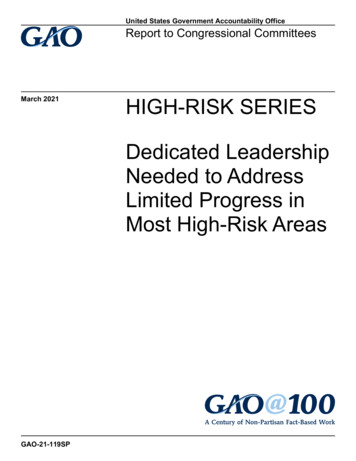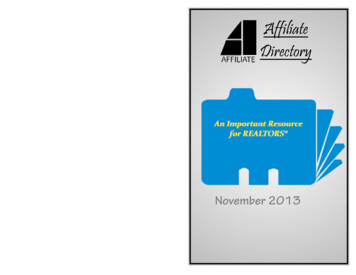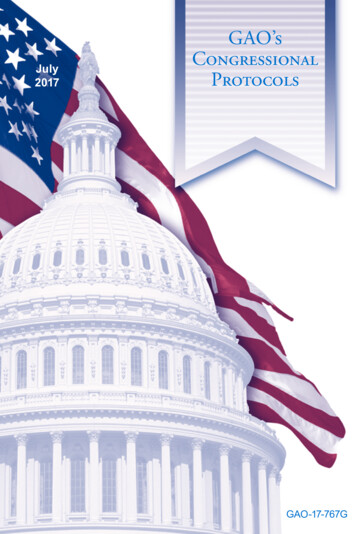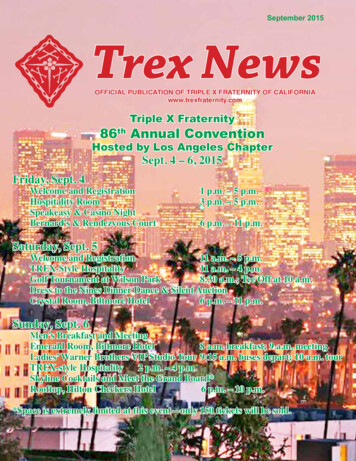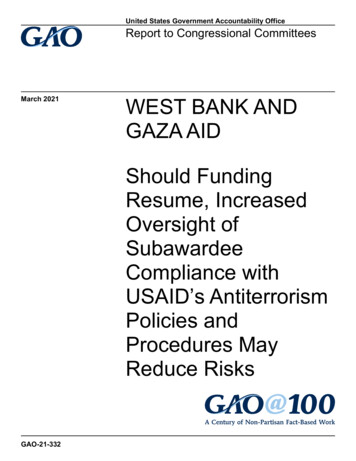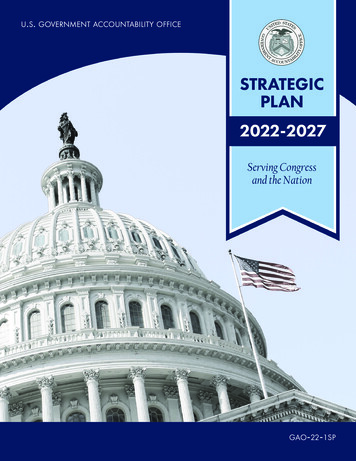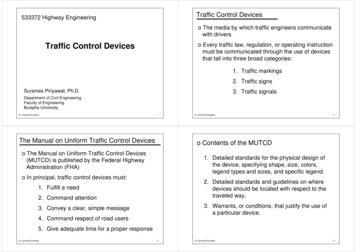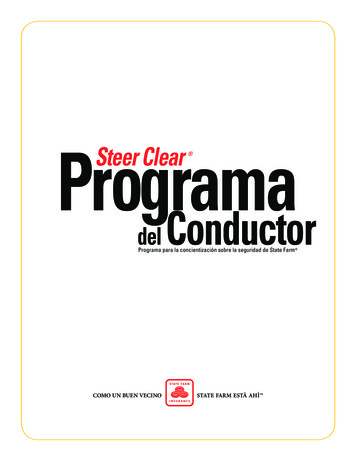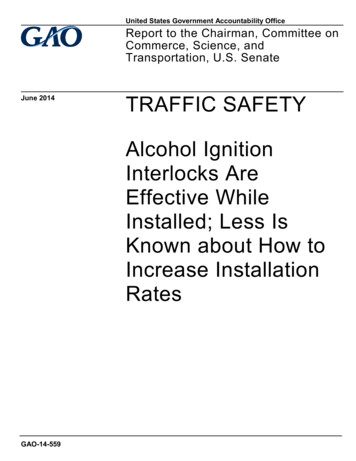
Transcription
United States Government Accountability OfficeReport to the Chairman, Committee onCommerce, Science, andTransportation, U.S. SenateJune 2014TRAFFIC SAFETYAlcohol IgnitionInterlocks AreEffective WhileInstalled; Less IsKnown about How toIncrease InstallationRatesGAO-14-559
June 2014TRAFFIC SAFETYHighlights of GAO-14-559, a report to theChairman, Committee on Commerce, Science,and Transportation, U.S. SenateAlcohol Ignition Interlocks Are Effective WhileInstalled; Less Is Known about How to IncreaseInstallation RatesWhy GAO Did This StudyWhat GAO FoundMotor vehicle crashes involvingalcohol-impaired drivers killed 10,322people in 2012 and account for almostone third of all traffic fatalities annually.Ignition interlocks are one strategystates use to combat DWI. In 2012,MAP-21 established a grant programfor states that adopt and implementmandatory alcohol ignition-interlocklaws for all convicted DWI offenders.Funding authorization for this programexpires at the end of fiscal year 2014.Research GAO reviewed consistently indicated that when installed ignition“interlocks”—devices that prevent drivers from starting their cars if they havebeen drinking alcohol—effectively reduce the rate of re-arrest for driving whileintoxicated (DWI) when installed. But once the devices are removed, DWI rearrest rates return to pre-interlock rates. (Most studies use DWI arrest as a proxyfor alcohol-impaired driving.) Further, the National Highway Traffic SafetyAdministration (NHTSA) estimated that between 15 and 20 percent of offendersarrested for DWI actually install ignition interlocks. Many factors contribute to lowinstallation rates. For example, some states lack the resources to monitoroffenders to ensure they install ignition interlocks; other states require thatoffenders pay fees and penalties to be eligible to install ignition interlocks andreturn to driving with interlocks. State ignition interlock programs vary in terms ofhow they are designed, but little research exists on which specific interlockprogram characteristics—such as monitoring or length of installation—couldimprove the effectiveness of interlock programs. NHTSA is currently conductingstudies on factors that could help states improve installation rates or otherwiseimprove the effectiveness of their interlock programs. NHTSA expects thesestudies to be completed by 2015.GAO was asked to review theeffectiveness of ignition interlocks andNHTSA’s implementation of the newgrant program. This report discusses(1) what is known about ignitioninterlock effectiveness and (2) theextent to which NHTSA has assistedstates in implementing ignitioninterlock programs, including the grantprogram. GAO reviewed 25 studiesthat analyzed relationships betweenignition interlocks and DWI arrests andfatalities; interviewed NHTSA officialsand reviewed reports about NHTSA’sassistance to states; and interviewedrepresentatives from safety-advocacyand research organizations, andofficials involved with ignition-interlockprograms from 10 states. The stateswere selected based on grant programqualification and the number ofalcohol-impaired fatalities, amongother factors. The information fromthese states is not generalizable. DOTofficials reviewed a draft of this reportand generally agreed with the findings.DOT offered technical corrections,which we incorporated as appropriate.View GAO-14-559. For more information,contact Susan Fleming at (202) 512-2834 orflemings@gao.govNHTSA has offered a variety of technical assistance, research, and education tohelp states establish and improve their ignition-interlock programs, as well asimplement the ignition interlock grant program established by the Moving Aheadfor Progress in the 21st Century Act (MAP-21). While state officials confirmedthat NHTSA’s overall ignition-interlock-related activities have been useful, somequestioned NHTSA’s implementation of the ignition interlock grant program.Specifically, NHTSA’s implementation was based on the plain meaning of theauthorizing language in MAP-21, which did not include any reference toexemptions. As a result, states with “employer exemptions”—programs thatrequire offenders to drive only vehicles equipped with ignition interlocks forpersonal use but allow them to drive employer-owned vehicles for workpurposes—were disqualified. Some state officials told us these exemptions areseldom used in practice, but are important to maintain because they facilitate theability of offenders to work. According to NHTSA officials, they recognized that toqualify for the grant, many states would have to modify their ignition-interlocklaws to make them applicable to first time offenders and eliminate exemptions;therefore, few states were expected to qualify in the grant’s first years because itwould be difficult for state legislatures to change their ignition-interlock laws inthat time frame. In fiscal year 2013, 2 states qualified for the grant; most of theadditional 12 states that applied for the grant were disqualified at least in part dueto employer exemptions, but the legislatures in 2 of those states later removedsuch exemptions from their laws, resulting in 4 states qualifying for the grant infiscal year 2014. Because the ignition interlock grant is relatively new, the extentto which additional state legislatures may be willing or able to modify their laws toqualify for the grant is unclear. A 2012 NHTSA review of states’ impaired-drivinglaws found that at least 5 states’ ignition-interlock laws included employer vehicleexemptions, but additional states had other factors that would prevent them fromqualifying for the ignition-interlock grant.United States Government Accountability Office
ContentsLetter1BackgroundResearch Indicates Interlock Devices Are Effective WhileInstalled, but Installation Rates Are Low and Research onStrategies to Increase Rates Is LimitedNHTSA Provided Assistance to States for Ignition-InterlockPrograms, but Some State Officials Questioned NHTSA’sImplementation of MAP-21 GrantConcluding ObservationsAgency Comments2202425Appendix IObjectives, Scope, and Methodology27Appendix IIStudies on Ignition-Interlock Effectiveness30Appendix IIIGAO Contact and Staff Acknowledgments33Table 1: States That Applied For and Were Awarded MAP-21Ignition-Interlock Grants, Fiscal Years 2013 and 2014Table 2: Summary of Ignition-Interlock Effectiveness Research51611TablesFiguresFigure 1: A Driver Using an Ignition-Interlock DeviceFigure 2: A Generalized Depiction of an Ignition-Interlock ProgramPage i78GAO-14-559 Traffic Safety
TSAPRGTIRFAssociation of Ignition Interlock Program Administratorsblood alcohol concentrationCenters for Disease Control and PreventionDepartment of Transportationdriving while intoxicatedgrams per deciliterGovernors Highway Safety AssociationMothers Against Drunk DrivingMoving Ahead for Progress in the 21st Century ActNational Highway Traffic Safety AdministrationPreusser Research GroupTraffic Injury Research FoundationThis is a work of the U.S. government and is not subject to copyright protection in theUnited States. The published product may be reproduced and distributed in its entiretywithout further permission from GAO. However, because this work may containcopyrighted images or other material, permission from the copyright holder may benecessary if you wish to reproduce this material separately.Page iiGAO-14-559 Traffic Safety
441 G St. N.W.Washington, DC 20548June 20, 2014The Honorable John D. Rockefeller IVChairmanCommittee on Commerce, Science, and TransportationUnited States SenateDear Mr. Chairman:In 2012, motor vehicle crashes involving alcohol-impaired drivers killed10,322 people. While the number of such fatalities has dropped by 21percent over the last 10 years, almost one third of all traffic fatalitiesannually resulted from crashes involving an alcohol-impaired driver overthe same period. Breath alcohol “ignition interlocks” are devices thatprevent a driver from starting a car if the device detects a driver’s bloodalcohol concentration (BAC) above a certain threshold. 1 Ignition interlocksrepresent one of the strategies states use to combat alcohol-impaireddriving. California first piloted the use of ignition interlocks in 1986 fordrivers convicted of driving while intoxicated (DWI). 2 According to theNational Highway Traffic Safety Administration (NHTSA), all states haveenacted legislation requiring or permitting the use of ignition interlocks.Historically, Congress has provided funds for state programs to reducealcohol-impaired driving. Most recently, the 2012 surface transportationreauthorization act—Moving Ahead for Progress in the 21st Century Act(MAP-21)—also included funding for a new grant program for states withlaws mandating that all drivers convicted of DWI be allowed to drive onlyvehicles equipped with an ignition interlock. 3 NHTSA assists states inimplementing these programs and, in addition to other safetyorganizations, has funded research examining the effectiveness ofignition-interlock programs.1BAC is measured as a mass of alcohol per volume of blood. In the United States, thestandard measurement is represented as grams per deciliter (g/dL).2The specific criminal offenses pertaining to alcohol-impaired driving vary acrossjurisdictions and can include such terms as “driving under the influence of alcohol or drugs(DUI),”operating under the influence of alcohol or drugs (OUI),” or “driving whileintoxicated (DWI)” In this report, the term “driving while intoxicated (DWI)” is used tocapture all types of alcohol-impaired offenses.3Pub. L. No. 112-141, 126 Stat. 405 (2012).Page 1GAO-14-559 Traffic Safety
In light of the toll alcohol-impaired driving takes, you asked us to reviewthe effectiveness of ignition interlocks and NHTSA’s implementation ofthe MAP-21 ignition-interlock program. This report discusses (1) what isknown about the effectiveness of ignition interlocks in reducing alcoholimpaired driving and (2) the extent to which NHTSA has assisted states inimplementing ignition-interlock programs, including the MAP-21 ignitioninterlock grant program.To identify what is known about the effectiveness of ignition interlocks, wereviewed 25 studies conducted between 1990 and 2013 that analyzedrelationships between ignition interlock devices or programs and alcoholimpaired driving outcomes, including DWI arrests and DWI fatalities. Weidentified these studies from a literature search and recommendationsfrom organizations that conduct research on ignition interlocks, such asthe Pacific Institute for Research and Evaluation. To identify the types ofassistance that NHTSA provides to states to help them establish andimplement their ignition-interlock programs, we interviewed NHTSAofficials about their activities and reviewed reports describing NHTSA’signition-interlock-related research, technical assistance, and conferences.For both objectives, we interviewed representatives from safety advocacyorganizations such as the Governors Highway Safety Association (GHSA)and Mothers Against Drunk Driving (MADD). We also interviewed trafficsafety, criminal justice, department of motor vehicles or licensing, and lawenforcement officials from 10 states. The states were selected based onMAP-21 ignition-interlock grant program qualification, DWI fatalitynumbers in 2012 (most recent data available), and alcohol-impairedfatalities per 100-million vehicle-miles traveled as calculated by NHTSA.(See app. I for more information on scope and methodology and app. IIfor a list of reviewed studies.)We conducted this performance audit from July 2013 to June 2014 inaccordance with generally accepted government auditing standards,Those standards require that we plan and perform the audit to obtainsufficient, appropriate evidence to provide a reasonable basis for ourfindings and conclusions based on our audit objectives. We believe thatthe evidence obtained provides a reasonable basis for our findings andconclusions based on our audit objectives.BackgroundWhile alcohol-impaired driving fatalities have declined from over 21,113 in1982 to 10,322 in 2012, the proportion of such fatalities as a percent oftotal traffic-related fatalities has remained relatively constant—between30 and 32 percent—over the past 15 years. Congress has targeted thisPage 2GAO-14-559 Traffic Safety
persistent problem through legislation to encourage states to reduce theirillegal per se BAC limit. 4 For example, beginning in 1982, federallegislation authorized grants to states to establish an illegal per se BAClimit of 0.10 or greater while driving a motor vehicle. 5 In other words, withrespect to a BAC limit of 0.10, anyone whose blood contains 1/10th of 1percent of alcohol or higher would be deemed to be DWI. In the late1990s, Congress made grant funds available to states to encourage themto further lower the illegal per se driving BAC limit to 0.08. In 2000, theU.S. Department of Transportation Appropriations Act for fiscal year 2001included a provision that states must enact 0.08 BAC laws by fiscal year2004 or begin losing federal highway construction funds. According toNHTSA, all states had complied with that provision by 2004.NHTSA administers safety-incentive grant programs to assist states intheir efforts to reduce traffic-related fatalities, including alcohol-impairedfatalities. 6 NHTSA also provides guidance and technical assistance, setsand enforces safety performance standards for motor vehicles and motorvehicle equipment, and conducts research on driver behavior and trafficsafety. As part of such research, NHTSA works with traffic safetyorganizations, such as GHSA, MADD, and the Traffic Injury ResearchFoundation (TIRF).Through transportation legislation—including the Transportation EquityAct for the 21st Century 7, the Safe, Accountable, Flexible, EfficientTransportation Equity Act: A Legacy for Users 8, and MAP-21—Congresshas provided funds to states for programs to combat impaired driving(sometimes called “countermeasure programs”). These grant programs4Per se BAC laws establish the BAC level at which it is illegal per se (in itself) for a driverto operate a vehicle, regardless of the driver’s apparent condition or actions.5Pub. L. No. 97-364, § 101 (a), 96 Stat. 1738 (1982). Other federal legislation has beenenacted with the goal of keeping alcohol-impaired drivers off the road, including reducedfederal funding to states if they did not raise the minimum legal drinking age to 21 and theencouragement of “zero-tolerance laws” that set illegal per se BAC levels at 0.02 orgreater for drivers under age 21.6In fiscal year 2014, NHTSA requested a total budget of 828 million and 653 full timeequivalent employees . NHTSA personnel are located in Washington, D.C. and among 10regional offices.7Pub. L. No. 105-178, 112 Stat. 107 (1998).8Pub.L. No. 109-59, 119 Stat. 1144 (2005).Page 3GAO-14-559 Traffic Safety
are designed to encourage states to adopt and implement effectiveprograms to reduce driving under the influence of alcohol, drugs or thecombination of alcohol and drugs. Under the most recent countermeasureprogram, states qualify for federal funding based on their impaired drivingfatality rate and application requirements vary based on whether a statehas a low-, mid-, or high-range fatality rate. 9 In addition, MAP-21 createda new grant program with funds available to reward states that implementlaws requiring ignition interlocks for all individuals convicted of alcoholimpaired driving. Specifically, “The Secretary [of Transportation] shall make a separate grant under this subsectionto each State that adopts and is enforcing a mandatory alcohol-ignition interlock lawfor all individuals convicted of driving under the influence of alcohol or of driving whileintoxicated.” 10MAP-21 made up to 15 percent per fiscal year of the total amount of theimpaired-driving countermeasures grant available for the new ignitioninterlock grant—about 21 million out of 139 million in fiscal year 2013.Any ignition-interlock grant funds that are not awarded remain availablefor grants under the broader impaired driving countermeasures grantprogram. In fiscal year 2013, 14 states applied for the grant and 2 wereawarded funding, while in fiscal year 2014, 12 states applied and 4 wereawarded funding. (See table 1.) States that qualify for this grant can usethe funds for any authorized traffic safety program, including stateignition-interlock programs, other impaired driving countermeasures, oreven traffic safety activities not related to alcohol-impaired driving. Statescategorized as low-range have the most flexibility in how they may usegrant funds, while mid-range and high-range states must first obtainapproval from NHTSA for some activities and meet certain conditionsbefore they can be reimbursed. MAP-21 funding will expire at the end offiscal year 2014; Congress is considering reauthorizing funding for9NHTSA categorizes states as low-, mid- or high-range based on the average impaireddriving fatality rate. (Fatality rate is fatalities per 100-million vehicle-miles traveled.) It iscalculated based on the number of fatalities in motor vehicle crashes in a state thatinvolve a driver with a blood alcohol concentration of at least 0.08 percent for every 100million VMT. These calculations are based on Fatality Analysis Reporting System datafrom the most recently reported 3 calendar years for a state which are averaged todetermine the rate. MAP-21 specifies that low-range states are those with an averageimpaired driving fatality rate of 0.30 or lower; mid-range states are those with an averageimpaired driving fatality rate higher than 0.30 and lower than 0.60; and high-range statesare those that have an average impaired driving fatality rate of 0.60 or higher.10See Section 31105(a) of MAP-21, Pub. L. No. 112-141, 126 Stat. 405, 748 (2012).Page 4GAO-14-559 Traffic Safety
surface transportation programs—including the ignition-interlock grantprogram—for fiscal year 2015 and beyond.Table 1: States That Applied For and Were Awarded MAP-21 Ignition-InterlockGrants, Fiscal Years 2013 and 2014States that applied for theignition-interlock grantFiscal year 2013applicants and grantawardsFiscal year 2014applicants and grantawardsAlaska 0 0Arizona 0 346,639Arkansas 0 0Colorado 0 0 199,576 205,258Illinois 0 0Kansas 0 0Kentuckya 0Louisiana 0a 179,271 184,375New York 0aOregon 0 0Utah 0aVirginia 0 0Washington 0 416,356 378,847 1,152,628ConnecticutNew MexicoTotalSource: NHTSA. GAO-14-559aState did not apply for ignition-interlock grant.The first ignition interlock was developed in 1969, but early models reliedon alcohol sensors that were inconsistent in accurately identifying BAC. Inthe early 1990s, ignition interlock manufacturers began producing morereliable and accurate fuel cell sensors, which is a technology currently inuse. 11 In 1992, NHTSA published model technical specifications forignition interlocks that describe how ignition interlocks should perform andhow the device can be calibrated to meet the model specifications.NHTSA updated these specifications in 2013.11According to a 2013 MADD report, there were about 12 ignition interlock manufacturersand vendors in the U.S.Page 5GAO-14-559 Traffic Safety
Ignition interlocks currently in use have four basic elements:1. A breath alcohol sensor in the vehicle that records the driver’s BACand sends the signal to not start the engine if the BAC registers higherthan the predetermined limit (see fig. 1); 122. A retest system; 133. A tamper-proof system for mounting the part of the unit that preventsthe engine from starting, which is typically required to be inspectedevery 30 to 60 days to prevent circumvention; and4. A data-recording system that logs the BAC results (for the initial testand retests) each time the vehicle is turned on and off, the time periodthe vehicle was driven and mileage, and other data that may be usedby state authorities to monitor the offender’s behavior.12According to NHTSA, states’ requirements for maximum BAC thresholds vary, butgenerally they are set at 0.02 or 0.025.13The ignition interlock requires the driver to submit breath samples at random times toensure that the driver does not drink alcohol after the engine has been started. The driveris given several minutes to exit traffic and move to a safe location to take the test. If thebreathe sample is not provided or the sample exceeds the set point, the device may warnthe driver and activate an alarm (e.g., horn blowing, lights flashing) that will continue untilthe ignition is turned off or a breath sample that is within the acceptable limits is provided.For safety reasons, the interlock device cannot turn off the vehicle’s ignition once it hasbeen started.Page 6GAO-14-559 Traffic Safety
Figure 1: A Driver Using an Ignition-Interlock DeviceAccording to NHTSA, currently all states have enacted legislationrequiring or permitting the use of ignition interlocks and they generallyfollow the same overall installation and removal process, according toAssociation of Ignition Interlock Program Administrators (AIIPA). (Seefig. 2.)Page 7GAO-14-559 Traffic Safety
Figure 2: A Generalized Depiction of an Ignition-Interlock ProgramPage 8GAO-14-559 Traffic Safety
State ignition-interlock programs vary in a number of ways: Program design—Some states may incorporate the use of ignitioninterlocks pretrial 14, while other states may stipulate ignition interlocksonly upon conviction (i.e., a state sanctions a “license suspension”and then limits the offender to “interlock-restricted driving”). 15 Somestates impose interlock-restricted driving on all convicted DWIoffenders, while in other states this is only required of those withmultiple or high BAC convicted offenders. 16 Further, according toNHTSA, most states require a “hard suspension” period in which anoffender’s driving privileges are denied for a certain period of timebefore he or she may be eligible for interlock-restricted driving. Statelaws and requirements may prescribe ignition interlock requirementsanywhere from a few months to as long as 10 years or more, oftenwith progressively longer ignition interlock requirements for DWIoffenders who are repeat offenders. Some states also exempt someDWI offenders from the application of their state interlockrequirements. For instance, some states allow employer exemptions,which allow offenders to drive employer-owned vehicles without anignition interlock for work purposes. Other states allow exemptions formedical reasons, such as allowing offenders who do not have thebreath capacity to blow a sample into an ignition interlock to not besubject to the ignition-interlock installation requirement while at thesame time suspending their license.14For example, Washington’s Department of Licensing administratively suspends anoffender’s license after arrest but before a DWI conviction. The state provides a period oftime for the driver to contest such a sanction as a means for providing due process. Thislicense suspension is separate from a DWI conviction, per se, as it can occur before trial.15States may suspend or revoke DWI offenders’ driving privileges pre- or post-convictionfor a period of time or offer the offender an option for partial license reinstatement uponcertain conditions such as the offender’s installing an interlock. In some states, anoffender may elect not to seek a partial license reinstatement, which is commonly referredto as “wait out.” For the purposes of this report, we refer to the suspension or revocation ofa driver’s license or loss of driving privileges as imposed by either the state licensingauthority or a judicial authority as a “license suspension” and we refer to the partialreinstatement of a driver’s license or court-ordered limitations on driving privileges as“interlock-restricted driving.”16In some states, DWI offenders may not be eligible for interlock-restricted drivingprivileges because of additional factors related to their DWI offense. For example, inIllinois, first time DWI offenders who have caused great bodily harm or death were noteligible for interlock-restricted driving privileges.Page 9GAO-14-559 Traffic Safety
Program delivery—Requirements for interlock-restricted driving canbe delivered programmatically in three different ways: through thejudiciary within the criminal justice system, administratively within thedriver licensing system, or using a hybrid approach that incorporatesboth judicial and administrative elements. According to AIIPA, 20states have judicial programs, 20 states have administrative interlockprograms, and 10 states have hybrid programs. According to NHTSA,in judicially-delivered interlock programs, judges have discretion toorder interlock-restricted driving and can threaten harsher sanctions(e.g., jail time) for non-compliance. In contrast, administrativelydelivered interlock programs are more uniform in imposingrequirements for interlock-restricted driving on DWI offenders and canextend interlock periods or withhold driver’s licenses (i.e., legal drivingprivileges) to encourage compliance, but have fewer sanction optionsat their disposal. There is a growing trend toward more hybridprograms.Oversight agency—In some states there may be a designated centralauthority that oversees implementation of certain aspects of thestate’s ignition-interlock program, such as a state department oftransportation or state law enforcement authority. This agency’s rolemay consist (1) of issuing state performance specifications for ignitioninterlocks; (2) of certifying the manufacturers’ equipment for use bytesting the equipment directly or by accepting test results asconducted by third party laboratories; (3) of approving ignitioninterlock vendors for business in the state; (4) of inspecting servicecenters; (5) of managing data from vendors; and (6) of managingstate funds to assist indigent offenders with ignition interlock costs,among other things.Program cost and funding sources—Program costs vary with thedesign of each ignition-interlock program. 17 For example, stateschoosing to monitor ignition interlock data on individual offender BACtests and driving habits will incur greater costs than states that do not.Programs that mandate offender appearances before a court oradministrative body for elevated BAC tests will incur greater coststhan programs that let the immediate inability to drive serve as theoffender’s sanction for an elevated test. States have varyingapproaches to funding the delivery of ignition-interlock programs,generally using fees paid by DWI offenders. Some states allocate17According to NHTSA, states typically require offenders to pay the fees associated withan ignition interlock, which in most states range between 65 and 90 per month, plusapproximately 100 to 250 for each installation.Page 10GAO-14-559 Traffic Safety
some portion of collected fees to create indigent funds available tohelp low-income DWI offenders with ignition-interlock costs.Research IndicatesInterlock Devices AreEffective WhileInstalled, butInstallation Rates AreLow and Research onStrategies to IncreaseRates Is LimitedResearch we reviewed consistently indicated that ignition interlocksreduce the rate of re-arrest for DWI while they are installed on the vehicle,but once removed, DWI re-arrest rates return to pre-interlock rates. Inaddition, the percentage of DWI offenders who actually install an interlockwhen ordered is estimated to be low. Several factors contribute to this lowrate, including low enforcement and monitoring to ensure offendercompliance and costly fees and penalties that DWI offenders have to paybefore they are eligible for interlock-restricted driving privileges. Littleresearch exists on which specific interlock program characteristics mayimprove installation rates or otherwise improve the effectiveness ofignition-interlock programs, but NHTSA’s ongoing and plannedresearch—expected to be completed between 2014 and 2015—may fillthis gap. 18Ignition-Interlock DevicesReduce Re-arrest WhileInstalledResearch consistently indicated that ignition interlocks are effective whileinstalled. That is, installation of ignition interlock devices in DWI offenders’vehicles reduces re-arrests for DWI when compared to alternativesanctions such as license suspension. Most studies use DWI arrest as aproxy for alcohol-impaired driving; however researchers have noted thatarrest for DWI is a rare event, with some estimating that less than 1percent of alcohol-impaired drivers are detected. 19 A 2011 review ofliterature assessing the effectiveness of ignition interlocks identified 15studies (12 in the U.S., 2 in Canada, and 1 on Sweden) that observedthat ignition interlock installation reduced the risk of being re-arrested forDWI offenders, compared to DWI offenders not using ignition interlocks.The studies included in this review primarily evaluated programs directedat drivers with multiple DWI offenses or first-time offenders with high BAC18For research studies we included in our review, see appendix II.19NHTSA officials noted that studies they reviewed showed that less that 1 percent ofdrivers who test positive for alcohol (BAC 0.01) are arrested, and that 2 percent of thosedrivers considered impaired at the time of the study were arrested.Page 11GAO-14-559 Traffic Safety
at arrest (usually 0.15). 20 As noted by the authors, the majority of studiesin this review and those that we separately identified did not randomlyassign participants to the ignition interlock; therefore, a limitation of manyof these studies remains the potential for selection bias, as individualswho agree to install an interlock may be inherently different fromindividuals who do not agree to do so. 21 However, we did identify tworandomized controlled trials, both in Maryland and limited to offenderswith two or more alcohol-related traffic violations, tha
implement the ignition interlock grant program established by the Moving Ahead for Progress in the 21st Century Act (MAP-21). While state officials confirmed that NHTSA's overall ignition-interlock-related activities have been useful, some questioned NHTSA's implementation of the ignition interlock grant program.
